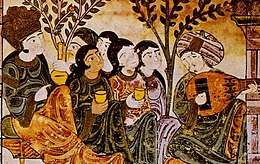Kufic
Kufic script (Arabic: الخط الكوفي) is a style of Arabic script that gained prominence early on as a preferred script for Quran transcription and architectural decoration, and it has since become a reference and an archetype for a number of other Arabic scripts. It developed from the Nabataean alphabet in the city of Kufa, from which its name is derived.[1] Kufic script is characterized by angular, rectilinear letterforms and its horizontal orientation.[1] There are many different versions of Kufic script, such as square Kufic, floriated Kufic, knotted Kufic, and others.[1]
Square Kufic
Square Kufic (Arabic: الكوفي المُرَبَّع), also sometimes known as banna'i (بنائي, "masonry" script), is a bare Arabic writing form that developed in the 12th century.[20][21] The calligrapher Mamoun Sakkal described its development as an "exceptional step towards simplification in Kufic styles that evolved towards more complexity in the preceding centuries."[20] Square Kufic was originally created in architecture with bricks and tiles functioning as pixels.[21] Legibility is not a priority of this script.[21]
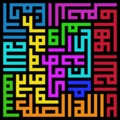
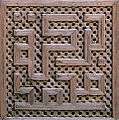 Geometric Kufic from the Bou Inania Madrasa (Meknes); the text reads بركة محمد or barakat muḥammad, i.e. Muhammad's blessing.
Geometric Kufic from the Bou Inania Madrasa (Meknes); the text reads بركة محمد or barakat muḥammad, i.e. Muhammad's blessing.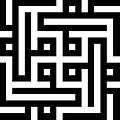 Another example of geometric or square Kufic script, showing four instances of the name Muhammad (in black) and four times Ali (in white); often used as a tilework pattern in Islamic architecture
Another example of geometric or square Kufic script, showing four instances of the name Muhammad (in black) and four times Ali (in white); often used as a tilework pattern in Islamic architecture The flag of Iran (1980)
The flag of Iran (1980)
- Banna'i on a minaret – a repetitive pattern of square Kufic inscriptions.
| Calligraphy |
|---|
Gallery
Kufic script in Qurans:
 Page from a Qur'an in Kufic style, 8th century (Surah 15: 67–74)
Page from a Qur'an in Kufic style, 8th century (Surah 15: 67–74)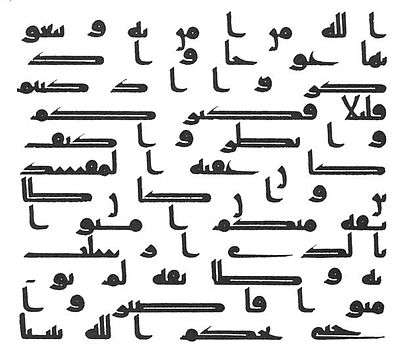 Kufic script from an early Qur'an manuscript, 8th-9th century. (Surah 7: 86–87)
Kufic script from an early Qur'an manuscript, 8th-9th century. (Surah 7: 86–87)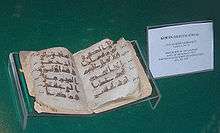 Manuscript of the Surat Maryam of the Qur'an; Kufic script on gazelle skin, 9th century. (Surah 19: 83–86)
Manuscript of the Surat Maryam of the Qur'an; Kufic script on gazelle skin, 9th century. (Surah 19: 83–86) The leaves from this Qur'an written in gold and contoured with brown ink have a horizontal format. (9th century)
The leaves from this Qur'an written in gold and contoured with brown ink have a horizontal format. (9th century)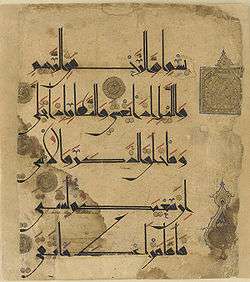
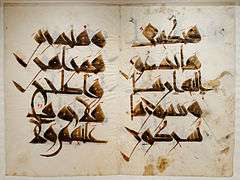 Bifolio of Surat Al-An'am in the "Nurse’s Quran” (مصحف الحاضنة), commissioned by a patron named Fatima under the Zirid Dynasty in the early 11th century.[22]
Bifolio of Surat Al-An'am in the "Nurse’s Quran” (مصحف الحاضنة), commissioned by a patron named Fatima under the Zirid Dynasty in the early 11th century.[22] Abbassid Quran, Persia, late 11th / early 12th century
Abbassid Quran, Persia, late 11th / early 12th century
Kufic script elsewhere:
 Bowl with Kufic Inscription, 9th century - Brooklyn Museum
Bowl with Kufic Inscription, 9th century - Brooklyn Museum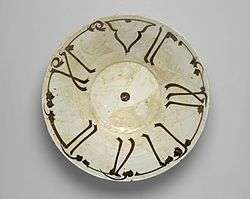 Bowl with Kufic Calligraphy, 10th century - Brooklyn Museum.
Bowl with Kufic Calligraphy, 10th century - Brooklyn Museum..jpg) 11th-century gold Fatimid armlet, inscribed with good wishes in the Kufic script, (Syria).
11th-century gold Fatimid armlet, inscribed with good wishes in the Kufic script, (Syria). Kufic alphabet, from Fry's Pantographia (1799)
Kufic alphabet, from Fry's Pantographia (1799) Almoravid Kufic adorning the Minbar of the Kutubiyya Mosque.
Almoravid Kufic adorning the Minbar of the Kutubiyya Mosque.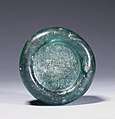 Inscription in Kufic (743). The Walters Art Museum.
Inscription in Kufic (743). The Walters Art Museum. Drawing of an inscription of Basmala in Kufic script, 9th century. The original is in the Islamic Museum in Cairo (Inventar-Nr. 7853)
Drawing of an inscription of Basmala in Kufic script, 9th century. The original is in the Islamic Museum in Cairo (Inventar-Nr. 7853) The flag of Iraq (2008)
The flag of Iraq (2008)
See also
- Maghrebi script
- Mashq script
- Hijazi script
- Ancient South Arabian script
- Ancient North Arabian script
- Thuluth
- Naskh
- Tawqi
- Muhaqqaq
- Rayhan
- Persian calligraphy
Notes
- www.metmuseum.org https://www.metmuseum.org/learn/educators/curriculum-resources/art-of-the-islamic-world/unit-two/the-development-and-spread-of-calligraphic-scripts#. Retrieved 2019-12-17. Missing or empty
|title=(help) - Blair, Sheila S. (2006). Islamic Caligraphy. p. 104. ISBN 978-0-7486-1212-3.
- Al-Amin, Salwa Ibraheem Tawfeeq. "The Origin of the Kufic Script": 3, 6. Cite journal requires
|journal=(help) - George, Alain (2010). The Rise of Islamic Calligraphy. pp. 55, 56, 57, 65, 72. ISBN 978-0-86356-673-8.
- Tan, Enis Timuçin (1999). "A Study of Kufic Script in Islamic Calligraphy and Its relevance to Turkish Graphic Art Using Latin Fonts in the late twentieth century": 42. Cite journal requires
|journal=(help) - Cohen, Julia (May 2014). "Early Qur'ans (8th–Early 13th Century)". www.metmuseum.org. Retrieved 2019-11-04.
- Al-Amin, Salwa Ibraheem Tawfeeq. "The Origin of the Kufic Script": 3, 6. Cite journal requires
|journal=(help) - Fraser, Marcus (2006). Ink and Gold Islamic Calligraphy. London. pp. 28, 46. ISBN 0954901487.
- George, Alain (2010). The Rise of Islamic Calligraphy. pp. 55, 56, 57, 65, 72. ISBN 978-0-86356-673-8.
- Jazayeri, S. M. V. Mousavi; Michelli, Perette E.; Abulhab, Saad D. (2017). A Handbook of Early Arabic Kufic Script: Reading, Writing, Calligraphy, Typography, Monograms. New York: Blautopf Publishing. p. 8. ISBN 9780998172743.
- Wilson, Eva (1988). Islamic Designs for Artists and Craftspeople. New York: Dover Publications. pp. 11. ISBN 048625819X.
- "Arabic scripts". British Museum. Retrieved 13 March 2013.
- "The Spirit of Islam: Experiencing Islam through Calligraphy". UBC Museum of Anthropology. Archived from the original on 8 November 2002. Retrieved 13 March 2013.
- Jazayeri, S. M. V. Mousavi; Ringgenberg, Patrick; Michelli, Perette E.; Chaharmahali, Ali M.; Jazayeri, S. M. H. Mousavi (2015). Kufic Inscriptions of the Historic Grand Mosque of Shoushtar. New York: Blautopf Publishing. p. 120. ISBN 9781511537995.
- George, Alain (2010). The Rise of Islamic Calligraphy. pp. 55, 56, 57, 65, 72. ISBN 978-0-86356-673-8.
- Ekhtiar, Maryam (July 2015). "Tiraz: Inscribed Textiles from the Early Islamic Period". www.metmuseum.org. Retrieved 2019-11-04.
- George, Alain (2010). The Rise of Islamic Calligraphy. pp. 55, 56, 57, 65, 72. ISBN 978-0-86356-673-8.
- Jonathan M. Bloom; Sheila Blair (2009). The Grove encyclopedia of Islamic art and architecture. Oxford University Press. pp. 101, 131, 246. ISBN 978-0-19-530991-1. Retrieved 4 January 2012.
- Mack, p.51
- Sakkal, Mamoun. (2004). Principles of Square Kufic Calligraphy. Hroof Arabiyya. 4. 4-12.
- "Creative Arabic Calligraphy: Square Kufic". Design & Illustration Envato Tuts+. Retrieved 2020-05-21.
- "Islamic art from museums around the world". Arab News. 2020-05-18. Retrieved 2020-05-18.
References
- Mack, Rosamond E. Bazaar to Piazza: Islamic Trade and Italian Art, 1300–1600, University of California Press, 2001 ISBN 0-520-22131-1
- Wolfgang Kosack: Islamische Schriftkunst des Kufischen. Geometrisches Kufi in 593 Schriftbeispielen. Deutsch – Kufi – Arabisch. Christoph Brunner, Basel 2014, ISBN 978-3-906206-10-3.
External links
| Wikimedia Commons has media related to Kufic style. |
- Square Kufic lectures: alphabet (stylized), examples, square designs
- Kufic manuscript alphabet
- On The Origins Of The Kufic Script
- Kufic Script
- Square Kufic Script
- Square Kufic
- Square Kufic explained
